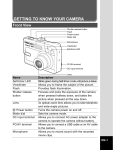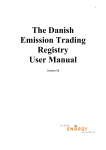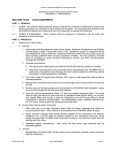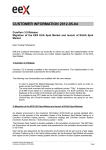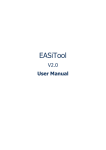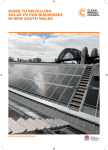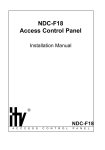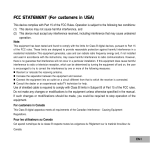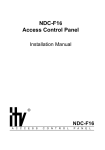Download User`s Manual
Transcript
EU ETS Database User’s Manual Version: 2.0 Last updated: 14 May 2007 TABLE OF CONTENTS 1. 1.1 GETTING STARTED................................................................................... 4 Introduction......................................................................................................... 4 1.2 How this manual is organised ............................................................................ 5 1.2.1 Notes for the user ........................................................................................ 5 2. GENERAL RULES AND COMMON FUNCTIONALITIES .......................... 6 2.1 Settings ................................................................................................................. 6 2.1.1 Format number ........................................................................................... 6 2.1.2 Tip functionality.......................................................................................... 6 2.1.3 Number of installations shown per page................................................... 6 2.1.4 Selection of years......................................................................................... 6 2.2 How to navigate in the database?...................................................................... 7 2.2.1 Levels............................................................................................................ 7 2.2.2 How to browse the database ? ................................................................... 7 2.3 How to sort data in the tables ? ......................................................................... 9 2.3.1 Data with a numeric format....................................................................... 9 2.3.2 Data with a text format............................................................................... 9 2.4 Data download (for subscribers to the Report Generator) ........................... 10 2.4.1 Lists of installations, graphs and tables .................................................. 10 2.4.2 Contact details........................................................................................... 11 2.5 Signification of symbols.................................................................................... 11 2.5.1 Emissions-to-cap symbols......................................................................... 11 3. MODULE START ...................................................................................... 12 4. MODULE BROWSE DATABASE ............................................................. 13 4.1 Level 1 : All countries ....................................................................................... 13 4.2 Level 2: Country ............................................................................................... 14 4.3 Level 3: Activity ................................................................................................ 15 4.4 Level 4: Installation .......................................................................................... 16 4.5 Level 5: Contact details .................................................................................... 17 EU ETS Database User’s Manual v2.0 2 Last updated: 14/05/2007 4.6 Emissions-to-cap charts.................................................................................... 18 4.6.1 Charts E-t-C vs EUAs............................................................................... 18 4.6.2 Charts E-t-C (MtCO2) ............................................................................. 20 4.6.3 Charts E-t-C ratio ..................................................................................... 21 4.7 5. 5.1 6 Benchmarking Tool .......................................................................................... 22 MODULE SEARCH DATABASE .............................................................. 24 Search options ................................................................................................... 24 MODULE COMPLIANCE .......................................................................... 26 ANNEX............................................................................................................. 28 GLOSSARY...................................................................................................... 28 TABLE OF ILLUSTRATIONS ILLUSTRATION 1: THE NAVIGATION BOX ........................................................................... 7 ILLUSTRATION 2: MODULE START ................................................................................... 12 ILLUSTRATION 3: LEVEL ALL COUNTRIES ........................................................................ 13 ILLUSTRATION 4: LEVEL COUNTRY ................................................................................. 14 ILLUSTRATION 5: LEVEL ACTIVITY.................................................................................. 15 ILLUSTRATION 6: LEVEL INSTALLATION .......................................................................... 16 ILLUSTRATION 7 : LEVEL CONTACT DETAILS ................................................................... 17 ILLUSTRATION 8 : MENU OPTION SEARCH DATABASE ..................................................... 24 ILLUSTRATION 9 : SEARCH QUERY ................................................................................... 25 ILLUSTRATION 10: CHART E-T-C VS EUAS PER COUNTRY .............................................. 18 ILLUSTRATION 11: CHART E-T-C VS EUAS PER ACTIVITY (ONE COUNTRY) .................... 19 ILLUSTRATION 12: EMISSIONS-TO-CAP CHART................................................................. 20 ILLUSTRATION 13: EMISSIONS-TO-CAP CHART................................................................. 21 ILLUSTRATION 14: E-T-C VS EUA CHART FOR THE COMBUSTION SECTOR ...................... 22 ILLUSTRATION 15: E-T-C CHART FOR THE COMBUSTION SECTOR .................................... 23 ILLUSTRATION 16: E-T-C RATIO CHART FOR THE COMBUSTION SECTOR .......................... 23 ILLUSTRATION 17: COMPLIANCE CHART .......................................................................... 26 EU ETS Database User’s Manual v2.0 3 Last updated: 14/05/2007 1. Getting started 1.1 Introduction The objective of this manual is to inform users on all the functionalities and information available in the EU ETS Database. We hope this document will help you use the EU ETS Database in a very natural and optimal way. For the definitions of the terms used in this manual, please refer to the glossary in the Annex. You can also access the glossary online, in the menu bar of the EU ETS Data interface. This manual will be updated each time a new tool or functionality is added. The last version of the manual is available for download on our website. If you experience a problem when using the tool and cannot find any answer in this manual, please contact our support team at [email protected] . We welcome your remarks and suggestions on how to improve the EU ETS Database. You can contact us at [email protected] . We wish you a nice reading. Information note : The information in this document is subject to change without notice and does not represent a commitment on the part of Carbon Market Data. Copyright © 2007 Carbon Market Data.. All rights reserved. EU ETS Database User’s Manual v2.0 4 Last updated: 14/05/2007 1.2 How this manual is organised The first chapter of this manual gives you an overview of the manual’s structure and familiarises you with the symbols that are used. The second chapter of this manual details the general rules and common functionalities of the EU ETS Database. It includes very important information and useful advice on settings preferences, navigation rules, how to sort and download the data, and on the meaning of symbols. The following chapters are structured by module. The third chapter presents an overview of the module “START”. The fourth chapter concerns the module “BROWSE DATABASE” and explains how to navigate through the whole EU ETS Database. The fifth chapter presents the module “SEARCH DATABASE” and details its unique functionalities. The final chapter presents the module “COMPLIANCE”. Finally, the glossary shown in the Annex gives a definition of all the terms used in the EU ETS DATA interface. 1.2.1 Notes for the user This symbol indicates important information on technical matters. This symbol indicates a useful tip or information on one of the functionalities of the EU ETS Database. EU ETS Database User’s Manual v2.0 5 Last updated: 14/05/2007 2. General rules and common functionalities 2.1 Settings 2.1.1 Format number To choose your preferred format number (point or comma as decimal and thousand separator), go to START and select the desired format in the Preferences table. By default, each time you log in to the EU ETS Database, the format number is set as the one used by your machine’s operating system. 2.1.2 Tip functionality To activate the tip functionality, which provides you with useful tips on how to navigate through the database, go to START and select the tip box. 2.1.3 Number of installations shown per page You can select the number of installations per page shown on the screen in each interface. When you are in the menu Browse Database / Top / Country / Activity, or in the menu Search Database, you can type the number of records per page desired in the box entitled “show 20 records”. The default value is 20, and the limit value is 999. It has to be noted that the totals shown at the bottom of the tables do not concern only the installations shown on the screen but concern all installations filtered by your query. 2.1.4 Selection of years In each module, you can select the years for which you want the information to appear. Just select the years in the filter box on the top of the screen and click on OK. Once you selected the desired years, your selection will remain valid in other modules. EU ETS Database User’s Manual v2.0 6 Last updated: 14/05/2007 2.2 How to navigate in the database? 2.2.1 Levels When you navigate inside the database, you can know where you are by looking at the “navigation box” (shown in the table below). This navigation box indicates you which part of the database you are currently viewing. In a more technical language, it shows you the path of your navigation and the filters you applied. top: country list country: Austria activity: Glass installation: Glasfabrik1 contacts: Illustration 1: The navigation box Example: In the illustration 1 shown above, the user is viewing the contact details of the installation “Glasfabrik1” in the Glass sector of the country Austria. 2.2.2 How to browse the database ? By default, when you open the Browse Database function, you see the list of all countries. When you click on the name of a country, a list of the country’s sectors is displayed. Then, when you click on one of the sector names, the list of installations belonging to this sector and to the previously selected country will appear. To see the details of a particular installation, just click on its name in the Installation column. Finally, to access the list of contacts related to this installation, just click on the contact details symbol . EU ETS Database User’s Manual v2.0 7 Last updated: 14/05/2007 * Example of navigation box: top: country list country: Austria activity: Paper installation: Papierfabrik1 contacts: In this example shown above, the user has clicked on the country Austria, then on the sector Paper, the installation entitled “Papierfabrik1” and finally clicked on the contact details symbol to view all the installation’s contact details. How to go up by one or more levels ? Important: After you completed your query, when you want to go up by one or more levels, just use the navigation box and click on the level you want to reach. When you navigate in the Search Database menu, click on SEARCH in the menu bar if you want to reinitialise your query. In the menu BROWSE, when you click on Top: country list in the navigation box, or on the menu title BROWSE, this erases all the filters applied and reinitialises your query. EU ETS Database User’s Manual v2.0 8 Last updated: 14/05/2007 2.3 How to sort data in the tables ? You can easily sort the information inside the table by just clicking on the column headers. 2.3.1 Data with a numeric format The first time you click on a column header that represents a numeric value, the column data (and all the records of the table) will be sorted in ascending order. If you click a second time, the column data (and all the records of the table) will be sorted in descending order. 2.3.2 Data with a text format When you click on a column header representing a field shown in a text format – such as the name of an installation – the column data (and all the records of the table) will be sorted in descending alphabetical order. If you click a second time, the column data (and all the records of the table) will be sorted again in ascending order, as shown by default. By default, the lists of countries, sectors and installations are sorted in the ascending alphabetical order of respectively the name of the countries, sectors or installations. EU ETS Database User’s Manual v2.0 9 Last updated: 14/05/2007 2.4 Data download 2.4.1 Lists of installations, graphs and tables (for subscribers to the Report Generator) To download the information you selected (i.e. filtered) in the database, just click on the Word or Excel icon and choose “Open the file” or “Save the file” in the message box. Click on this icon to download the data in MS Word format. Click on this icon to download the data in MS Excel format. Click on this icon to download a chart in PNG format. For contact reports, the download of information is limited to 7000 installations at a time. We therefore advise you to download contacts reports country per country. There is no limit for installations reports. When you generate a report (in Word or Excel) and download the information, the report generated not only includes the installations shown on the screen but includes all the records (the installations) filtered. When you download a file, please wait until the file has been totally downloaded before clicking on another part of the database. Otherwise, you risk to be disconnected automatically by the server. Important tip for securing your download : to avoid any problem during the download process, after you clicked on “Open the file” or “Save the file” please wait a few seconds before clicking on another part of the database. . EU ETS Database User’s Manual v2.0 10 Last updated: 14/05/2007 2.4.2 Contact details The database shows the contact details of all installations. Several contact details are provided for each installation. For a detail on these contact details, see paragraph 4.5 . To download the contact details of installations in Word or Excel format, click on “Search database” in the menu bar. In the search criteria, select a country and then click on the icon “Generate Contact Word/Excel report”. 2.5 Signification of symbols 2.5.1 Emissions-to-cap symbols : The emissions-to-cap is < 0. There is a surplus of allowances. : The emissions-to-cap is > 0. There is a lack of allowances. : Data not available. EU ETS Database User’s Manual v2.0 11 Last updated: 14/05/2007 3. Module START In this introductory module, you can: • Choose your preferred number format by clicking on one of the two options proposed (point or comma as decimal and thousand separators) in the table entitled « Preferences ». • Enable or disable the tip box. Illustration 2: Module Start EU ETS Database User’s Manual v2.0 12 Last updated: 14/05/2007 4. Module BROWSE DATABASE In this module, you can browse the database in a very convenient way. There are five levels of browsing : 1st level : all countries 2nd level : country 3rd level : activity 4th level : installation 5th level : contact details 4.1 Level 1 : All countries The table All countries –shown below – displays all the totals per country: • • • • • • Number of installations Distributed allowances Verified emissions figures Emissions-to-cap Emissions-to-cap ratio Emissions-to-cap year-on-year evolution Illustration 3: Level All countries EU ETS Database User’s Manual v2.0 13 Last updated: 14/05/2007 * Reminder: Signification of symbols : The emissions-to-cap is < 0. There is a surplus of allowances. : The emissions-to-cap is > 0. There is a lack of allowances. : Data not available. Click on this icon to download the data in MS Word format. Click on this icon to download the data in MS Excel format. Click on this icon to download a chart in PNG format. 4.2 Level 2: Country Here you can see the totals for the country and each of its sectors. You access to this level by just clicking on the name of the country of your choice. Illustration 4: Level Country EU ETS Database User’s Manual v2.0 14 Last updated: 14/05/2007 4.3 Level 3: Activity You access to this level by clicking on the name of one of the sectors of activity. Here you can see the list of installations included in the sector of activity. Illustration 5: Level Activity The last row of the table shows you the totals for all the installations belonging to the selected sector of activity (and not only the totals for the installations that appear on the screen). EU ETS Database User’s Manual v2.0 15 Last updated: 14/05/2007 4.4 Level 4: Installation This level displays all the information on a particular installation: name, address, number of distributed allowances, verified emissions and emissions-to-cap figures, surrendered allowances and compliance status.. Illustration 6: Level Installation Click on this icon to download the data in MS Word format. Click on this icon to download the data in MS Excel format. EU ETS Database User’s Manual v2.0 16 Last updated: 14/05/2007 4.5 Level 5: Contact details This level displays the list of contacts details related to the installation: • • • • • Installation’s contact details Account holder ‘s contact details (the company that manages the installation ‘s allowances) Contact details of the primary representative of the account holder Contact details of the secondary representative of the account holder Contact details of the verifier’s representative (when available) All installations ‘contact details are downloadable (to see instructions, refer to the paragraph 2.4.1 of this manual). Illustration 7 : Level Contact details EU ETS Database User’s Manual v2.0 17 Last updated: 14/05/2007 2.5 Emissions-to-cap charts The emissions-to-cap figure is equal to the difference between the distributed allowances and the verified emissions. It is calculated for each country, sector and installation. You can view the results through a series of nice charts. Click on this icon to view the emissions-to-cap charts 4.6.1 Charts E-t-C vs EUAs The charts E-t-C vs EUAs display the total of distributed allowances versus the calculated emissions-to-cap. The red colour indicates the lack of distributed allowances, whereas the green colour represents the surplus of distributed allowances. The illustration below shows the totals per country. Illustration 8: Chart E-t-C vs EUAs per country EU ETS Database User’s Manual v2.0 18 Last updated: 14/05/2007 The illustration below shows the emissions-to-caps versus distributed allowances for Austria, detailed by activity. Illustration 9: Chart E-t-C vs EUAs per activity (one country) download chart Click on this icon to download a chart in PNG format (only for Report Generator ‘s subscribers). EU ETS Database User’s Manual v2.0 19 Last updated: 14/05/2007 4.6.2 Charts E-t-C (MtCO2) To view the charts E-t-C (MtCO2), click on the icon E-t-C (MtCO2). The chart E-t-C (MtCO2), as shown below, displays the emissions-to-cap figures in volume (Mt CO2). Illustration 10: Emissions-to-cap chart (MtCO2) EU ETS Database User’s Manual v2.0 20 Last updated: 14/05/2007 4.6.3 Charts E-t-C ratio To view the charts E-t-C ratio, click on the icon E-t-C (%). The chart E-t-C ratio, as shown below, displays the emissions-to-cap figures in ratio (as a percentage of the distributed allowances). Illustration 11: Emissions-to-cap ratio chart (% of cap) EU ETS Database User’s Manual v2.0 21 Last updated: 14/05/2007 4.7 Benchmarking Tool The module BROWSE can be used as a powerful benchmarking tool. By selecting the criterion “country: All” and a specified sector of activity, you can then compare the emissions-to-cap of a particular sector between each country. The three illustrations below display the emissions-to-cap of the combustion sector for each country. Illustration 12: E-t-C vs EUA chart for the combustion sector EU ETS Database User’s Manual v2.0 22 Last updated: 14/05/2007 Illustration 13: E-t-C chart for the combustion sector (MtCO2) Illustration 14: E-t-C ratio chart for the combustion sector EU ETS Database User’s Manual v2.0 23 Last updated: 14/05/2007 5. Module SEARCH DATABASE 5.1 Search options In this module you can search the database just the way you want. This searching tool displays all the fields on which to apply your query. You can apply search criteria on the following fields: • • • • • • • Country Activity Installation / Account holder name Permit Identifier Number of allowances Verified emissions above/below the cap Compliance status Illustration 15 : Menu option Search Database EU ETS Database User’s Manual v2.0 24 Last updated: 14/05/2007 * Reminder The download of contact information is limited to 7000 installations at a time. We therefore advise you to download contacts reports country per country. When you generate a report (in Word or Excel) and download the information, the report generated not only includes the records shown on the screen but includes all the records filtered. Important tip for securing your download : to avoid any problem during the download process, wait a few seconds after you click on “Open the file” or “Save the file” before clicking on another part of the database. To reinitialise your search, click on SEARCH in the menu bar. To refine your search, click on “Show filter” and select additional search criteria. Example: The illustration below shows the result of a query with the selection criteria Country/Austria and Activity/Cement & Lime. Illustration 16 : Search query EU ETS Database User’s Manual v2.0 25 Last updated: 14/05/2007 6 Module Compliance This module displays the number of installations that had a surplus or a lack of allowances by country and by activity. Illustration 17: Compliance module Note: The numbers shown in the illustration above are drawn from the free version of our EU ETS database (six countries only). LOG OUT: To log out of the application, you can just close the window or click on the menu tab « QUIT ». Copyright © 2006 Carbon Market Data Ltd. All rights reserved. EU ETS Database User’s Manual v2.0 26 Last updated: 14/05/2007 Contact Us Carbon Market Data 95 Wilton Road Suite 3 London SW1V 1BZ United Kingdom Tel: +44 (0) 845 868 5393 General enquiries: [email protected] Sales department: [email protected] Technical support: [email protected] Feedback on EU ETS Database: [email protected] Copyright notice The EU ETS Database User Manual and all its contents are protected by copyright and are the property of Carbon Market Data. All rights reserved. This manual may not – in all or in part – be copied or reproduced without the express written permission of Carbon Market Data. Carbon Market Data does not undertake any liability for the correctness of the EU ETS Database User Manual. The content of the database, as well as of the EU ETS Database User Manual, may be changed without prior warning. Copyright © 2007 Carbon Market Data. All rights reserved. EU ETS Database User’s Manual v2.0 27 Last updated: 14/05/2007 ANNEX Glossary (of the terms used in the EU ETS Database) A Account holder This field shows the name of the person or the company that manages the installation’s allowances and registry account. Activity Here is the list of sectors of activity and their description as defined by the Community Transaction Log (for more detailed information, you can refer to the Annex I of the EU Emissions Trading Scheme directive): Combustion: Combustion installations with a rated thermal input exceeding 20 MW Refining: Mineral oil refineries Coke ovens: Coke ovens Roasting & Sintering: Metal ore (including sulphide ore) roasting or sintering installations Iron & Steel: Installations for the production of pig iron or steel (primary or secondary fusion) including continuous casting Cement & Lime: Installations for the production of cement clinker in rotary kilns or lime in rotary kilns or in other furnaces Glass: Installations for the manufacture of glass including glass fibre Bricks & Ceramics: Installations for the manufacture of ceramic products by firing, in particular roofing tiles, bricks, refractory bricks, tiles, stoneware or porcelain Paper: Industrial plants for the production of (a) pulp from timber or other fibrous materials (b) paper and board Other: Other activities or installations opted-in pursuant to Article 24 of Directive 2003/87/EC Allowance Permit to emit one tonne of carbon dioxide equivalent. B Bricks & Ceramics Sector of activity that includes installations for the manufacture of ceramic products by firing, in particular roofing tiles, bricks, refractory bricks, tiles, stoneware or porcelain. EU ETS Database User’s Manual v2.0 28 Last updated: 14/05/2007 C Cap The installation cap is equal to the number of EU allowances (EUAs) it has received for free (distributed allowances). Cement & Lime Sector of activity that includes installations for the production of cement clinker in rotary kilns, or lime in rotary kilns or in other furnaces. Coke ovens Sector of activity that includes all types of coke ovens. Combustion Combustion installations with a rated thermal input exceeding 20 MW. D Distributed Allowances Number of allowances distributed for free to an installation by each Member State. E Emissions-to-cap (E-t-C) Emissions-to-cap = verified emissions - distributed allowances If E-t-C > 0, it means that the installation has emitted more emissions than the number of allowances it has received for free. It has therefore a short position in the market, and must buy EU allowances, CERs or ERUs to make up with the difference. It can also borrow the allowances distributed the year after (providing they were issued in the same phase of the scheme) and use them for compliance. If E-t-C < 0, it means that the installation has a surplus of allowances and therefore has a long position in the market. It can then sell its surplus of allowances in the market or keep them for future compliance or future sale. Emissions-to-cap ratio (E-t-C ratio) E-t-C ratio (%) = ( (verified emissions – distributed allowances) / distributed allowances ) x 100 The emissions-to-cap ratio is equal to the emissions-to-cap figure divided by the distributed allowances, expressed in percentage. It shows by how many percent an installation emits above or under its cap (number of distributed allowances). Verified Emissions Evolution (year n+1 / year n) Verified emissions evolution (year n+1 / year n) (%) = ((verified emissions year n+1) – (verified emissions year n) x 100) / (verified emissions year n) EU ETS Database User’s Manual v2.0 29 Last updated: 14/05/2007 EU ETS Stands for European Union’s Emissions Trading Scheme. The European Union’s emissions trading scheme includes the 25 EU countries and will be joined in 2007 by the two new Member States, Bulgaria and Romania. It started in 2005 and will run until at least 2012. It is designed in two phases : first phase during the years 2005-2007 and second phase in 2008-2012 (which corresponds to the Kyoto Protocol compliance period). A third phase of the EU ETS (post-2012) is currently discussed. For further information, please refer to the EU ETS directive. G Glass Sector of activity that includes installations for the manufacture of glass, including glass fibre. I Installation As defined in the EU ETS directive, ‘installation’ means a stationary technical unit where one or more activities (listed in Annex I of the directive) are carried out and any other directly associated activities which have a technical connection with the activities carried out on that site and which could have an effect on emissions and pollution. Iron & Steel Sector of activity that includes installations for the production of pig iron or steel (primary or secondary fusion) including continuous casting. O Other Other activities or installations opted-in pursuant to Article 24 of Directive 2003/87/EC. P Paper Sector of activity that includes industrial plants for the production of (a) pulp from timber or other fibrous materials (b) paper and board Permit identifier Number of the installation’s emissions permit. Each installation included in the EU ETS must hold a greenhouse gas emissions permit, which is issued by the competent national authority. EU ETS Database User’s Manual v2.0 30 Last updated: 14/05/2007 R Refining Sector of activity that includes mineral oil refineries. Roasting & Sintering Sector of activity that includes metal ore (including sulphide ore) roasting or sintering installations. S Surrendered allowances At 30 April each year at the latest, the operator of each installation must surrender to the competent national authority a number of allowances equal to the total verified emissions emitted from that installation during the preceding calendar year. V Verified emissions Amount of emissions actually emitted by an installation. Each installation‘s emissions are monitored and verified by independent third-parties in accordance with the monitoring and reporting guidelines published by each Member State. EU ETS Database User’s Manual v2.0 31 Last updated: 14/05/2007































